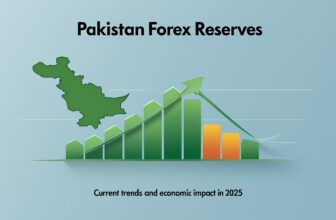
Forex leverage seems to be one of the most tricky topics for beginners at first. It is actually a concept that enables a trader to control a big position with a small amount of capital, amplifying profits but also increasing risk. The use of leverage enables traders to open positions worth much more than the actual deposit in the forex market.
Leverage is a common tool among forex traders because it can enhance trading power. However, it’s essential to grasp the concept fully to avoid substantial losses. Setting up a forex leverage account is just the beginning; mastering risk management strategies is crucial to protect your investment.
I invite you to explore how leverage can work for you and the strategies you can implement to manage risks effectively. This article will guide you through the ins and outs of forex leverage, helping you to navigate the forex market more confidently.
Key Takeaways
- Forex leverage allows for larger trades with less capital.
- Managing risk is essential when using leverage.
- Understanding leverage can improve your trading strategy.
Understanding Forex Trading and Leverage

Forex trading involves buying and selling currency pairs to profit from changes in exchange rates. It allows traders to enter the market with less money than they would need without leverage. Leverage lets traders control larger amounts of currency with a smaller investment. This can lead to greater profits or losses.
Basics of Forex Trading
In the forex market, currencies are traded in pairs, like EUR/USD or GBP/JPY. Each currency pair has a base currency and a quote currency. The base currency is the first one listed, while the quote currency shows how much of the second currency is needed to buy one unit of the first. Traders speculate on whether a currency will rise or fall in value to make profits.
Forex trading operates 24 hours a day, five days a week, allowing for flexible trading schedules. The market is known for its high liquidity, meaning traders can quickly buy or sell their positions. Understanding how price movements work is essential for developing a successful trading strategy.
What Is Leverage in Forex Trading?
Leverage in forex allows traders to control a larger position with a smaller amount of capital. For example, a leverage ratio of 100:1 means I can control $100,000 in forex with just $1,000 in my trading account. This amplifies potential gains but also increases the risk of significant losses.
Using leverage means that I can open larger positions than my account balance would normally allow. However, it’s crucial to use it wisely to avoid margin calls, which happen when my account balance falls below the required margin level. High leverage can lead to quicker profits but also larger losses.
Differences Between Leverage Ratios and Margin
Leverage ratios and margin are closely related but represent different concepts in trading. The leverage ratio indicates how much more you can trade than you have in your account. For example, a leverage ratio of 50:1 means you can control 50 times the amount of your initial deposit. If a trader would deposit $1,000, they can open positions worth up to $50,000 using this leverage.
Margin, on the other hand, is the amount of money that must be kept in your trading account as collateral to open a position using leverage. For instance, if you are trading with a leverage ratio of 100:1, the margin requirement to trade a standard lot (which is typically 100,000 units of currency) would be just 1% of the total trade value. This means you’d need only $1,000 to control a $100,000 position in the foreign exchange market.
| Aspect | Leverage Ratio | Margin |
|---|---|---|
| Definition | The ratio indicates how much more you can trade compared to your deposit. | The amount of money required as collateral to open a leveraged position. |
| Example | 50:1 leverage means controlling $50,000 with a $1,000 deposit. | For 100:1 leverage, a standard lot ($100,000) requires a $1,000 margin. |
| Purpose | Allows traders to control larger positions with less capital. | Ensures traders have enough funds to cover potential losses. |
| Impact on Trading | Amplifies both potential profits and losses. | If equity falls below the margin requirement, positions may be closed. |
| Relation to Position Size | Determines the total position size you can control. | Determines the minimum deposit needed to open that position. |
| Risk | Higher leverage increases the risk of large losses. | Insufficient margin can lead to a margin call or forced liquidation. |
| Common Usage | Applied in forex, CFDs, and commodity futures trading. | Used as a safety net to manage leveraged trades. |
To understand how leverage works, consider this example: if a trader wants to start trading in commodity futures or CFDs (Contracts for Difference), the leverage provided allows them to take large positions with a relatively small amount of capital. Leverage ratios can range from 10:1 to as high as 500:1, depending on the broker and market conditions. This means traders can amplify their potential profits, but they also risk magnifying their losses if the market moves against them.
When using leverage like 200:1, a small market movement can have a significant impact on the trader’s equity. If the position loses value and the account balance falls below the margin requirement, the broker may execute a margin call and automatically close positions to limit further losses. This is why understanding both leverage ratios and margin is crucial for effective risk management in trading.
By grasping how leverage works and the role of margin, traders can better navigate the risks and rewards of leveraged trading, whether in forex, CFDs, or commodity futures.
Setting Up a Forex Leverage Account

When starting with a forex leverage account, it’s essential to navigate key components. I will focus on selecting the right broker, understanding margin requirements, and recognizing how account balance influences leverage.
Choosing a Forex Broker
Selecting a forex broker is a critical step. I need to look for one that offers suitable leverage options and favorable trading conditions. Brokers often provide different leverage ratios, sometimes up to 1:500. This means I can control larger positions with a smaller amount of capital.
I should verify the broker’s regulation status. A regulated broker offers more security for my funds. Additionally, it’s wise to read reviews and compare fees. Many brokers charge spreads or commissions, which can affect my profits on forex trades.
I will also consider the trading platform they offer. A user-friendly platform can enhance my trading experience, allowing me to make decisions quickly.
Understanding Margin Requirements
Margin is the amount of capital required to open a leveraged position. When trading with leverage in forex, brokers set a margin requirement, usually expressed as a percentage.
For example, if the margin requirement is 1%, I need to deposit $1,000 to control a $100,000 position. Understanding this ratio helps me manage my risk better. The lower the margin requirement, the higher the leverage I can use.
Failure to meet margin calls can result in account liquidation. Thus, I must ensure my financial situation allows me to cover potential losses when using leverage. Knowing the specific requirements will aid my trading strategy.
The Role of Account Balance in Leverage
My trading account balance directly affects how much leverage I can use. A higher account balance can offer greater flexibility with leveraging. If my account balance is low, I might face restrictions on the maximum leverage allowed.
Moreover, my leverage level impacts my risk management. I should carefully consider how much leverage I want to use based on my risk tolerance. Using high leverage can amplify profits but also increase potential losses significantly.
By maintaining a sufficient account balance, I can reduce the chance of margin calls and manage my positions more effectively. Properly understanding the interplay between account balance and leverage is crucial for successful forex trading.
Risk Management Strategies

Managing risk is crucial for successful trading. It involves planning how to protect trading capital while maximizing potential gains. I will discuss effective methods that can help you stay in control of your trades.
Using Stop-Loss Orders Effectively
A stop-loss order is a tool that can help me limit losses on a trade. By setting a specific price at which a trade will close automatically, I can protect my capital. For instance, if I buy a currency pair at $1.2000, I might set a stop-loss order at $1.1950. This means if the price falls to $1.1950, the trade closes, limiting my loss.
Using stop-loss orders effectively requires careful planning. I should place them based on market volatility and my trading strategy. The key is to ensure that the stop-loss is not too close to the entry price, which could trigger it unnecessarily, or too far, which could lead to larger losses.
The Importance of Risk Tolerance
Understanding my risk tolerance is vital in trading. This refers to how much risk I can handle without feeling stressed. Each trader’s risk tolerance differs, influenced by factors like experience, trading capital, and financial goals.
Assessing my risk tolerance helps me decide how much capital to risk on each trade. A common guideline is to risk only 1-2% of my account on a single trade. This way, even a few losses won’t significantly impact my trading capital. Recognizing my limits allows me to trade more confidently and make rational decisions.
Managing Leverage and Position Sizing
Leverage can amplify both profits and losses. It’s essential for me to manage it carefully. In forex trading, leverage ratios can be as high as 100:1 or more. While high leverage can lead to quick gains, it can also cause significant losses if not used wisely.
I must consider my position size according to my leverage. For example, if I have a balance of $1,000 and use 100:1 leverage, I can control $100,000 in trades. However, if the market moves against me, my losses could quickly cut deep into my capital. Keeping leverage reasonable and aligning my position size with my risk tolerance ensures I maintain a stable trading approach and protect my capital.
Maximizing Trading Opportunities with Leverage

Using leverage wisely can help traders unlock better profit potential in the forex market. I will discuss how to identify high leverage trading opportunities, the benefits of amplifying profits, and the risks associated with using leverage.
Identifying High Leverage Trading Opportunities
To find trading opportunities with high leverage, I focus on market volatility. This means looking for currency pairs that show significant price movements. Major pairs like the EUR/USD or GBP/USD often provide good leverage options.
I also consider the economic events or news releases that can affect currency prices. Events like interest rate changes or employment reports can lead to price swings. These fluctuations create openings for profit when using leverage.
Additionally, I pay attention to the leverage ratios offered by brokers. Understanding the amount of leverage that a broker provides helps me choose the best one for my trading strategy.
Benefits of Amplifying Profits
Using leverage can significantly amplify profits from forex trades. For example, if I have a trading account with $1,000 and use a leverage ratio of 100:1, I can control a position worth $100,000. This means that even small price movements in currency pairs can yield substantial returns.
Leverage allows me to use less of my own capital while maintaining a larger trading position. This efficiency can lead to greater profit potential without necessitating a higher deposit. I can diversify my trades across different currency pairs, spreading risk and enhancing my chances for gains.
Nevertheless, it’s crucial to use good leverage. Finding the right balance between high leverage and manageable risk is vital for successful trading.
Understanding the Risks Associated with Leverage
While leverage can boost profits, it also increases the risk of substantial losses. If a trade goes against me, losses can quickly surpass my initial capital. This is because I am responsible for the entire position value, not just my deposit.
I always assess my risk tolerance and set clear stop-loss orders to protect my account. Utilizing lower leverage can be a proactive strategy to manage risk.
Leverage can lead to margin calls if my account balance falls below the required level. I must ensure I have a solid trading plan in place and be prepared for the market’s volatility. Balancing potential rewards with associated risks is key to navigating the forex trading landscape effectively.
Advanced Considerations for Leverage Trading
When trading with leverage, understanding how it impacts your investments is crucial. Key factors such as price movements, liquidation risks, and trading strategies play significant roles in determining success in the forex market.
Analyzing the Impact of Price Movements
Price movements can significantly affect traders using leverage. Small changes in currency prices can lead to large gains or losses because leverage amplifies the effect of these fluctuations. For example, a 1% change in a currency pair might impact a leveraged trade by 10% or more, depending on the leverage ratio used.
Traders must monitor price movements closely. I focus on technical analysis to identify trends and reversals. This strategy helps me navigate potential risks associated with high leverage. Understanding volatility, especially during economic events, is essential. Sudden market shifts can trigger rapid losses, making risk management critical.
Leverage and Liquidation
Liquidation occurs when a broker closes a trader’s position because the account balance falls below the required margin. When using high leverage, the risk of liquidation increases. For instance, a trader with a leverage ratio of 100:1 can quickly face liquidation if the market moves against them.
I emphasize the importance of maintaining sufficient capital in my trading account. A well-managed margin helps buffer against sudden market changes. I continually assess my positions to ensure they align with my risk tolerance and trading strategy. Setting stop-loss orders can also mitigate liquidation risks.
Incorporating Leverage into Trading Strategy
A well-thought-out trading strategy is vital when incorporating leverage. I recommend using a moderate leverage ratio to manage risk effectively. High leverage can amplify profits but also increases potential losses.
My approach includes starting with lower leverage and gradually increasing it as I gain experience and confidence. This method allows me to understand the dynamics of leveraged trading without exposing myself to excessive risks. Regularly reviewing my trading performance and adjusting my strategy is essential for long-term success in the forex market.
















